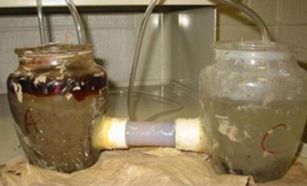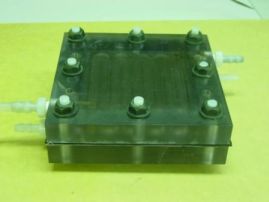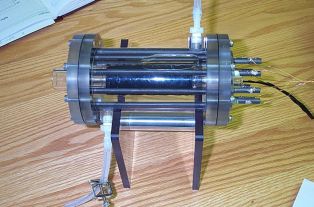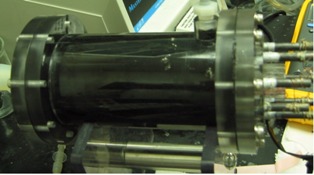Boston University/Why Shewie
From 2007.igem.org
< Boston University(Difference between revisions)
(→References) |
|||
| (41 intermediate revisions not shown) | |||
| Line 1: | Line 1: | ||
| - | [[Image: | + | [[Image:bu_shewie2.jpg|center]] |
| - | + | ==Reasons for Working with Shewie== | |
| - | + | ===Flexible Metabolism=== | |
| - | + | :Electrogenic microbes are microscopic organisms that have evolved the ability to breakdown organic or chemical material, extract electrons from the material, and pass those electrons to extracellular organic or inorganic substrates such as Fe(III) or graphite electrodes. In particular, we will be working with the electrogenic microbe Shewanella oneidensis. | |
| - | Previous work in the Gardner Laboratory at Boston University has produced a map of 800 regulatory interactions controlling metabolism and electron transport in S. oneidensis transcription networks. These transcription networks contain a complete listing of which proteins control synthesis of other proteins. | + | :In S. oneidensis, electron donors for respiration can range from lactate to pyruvate to amino acids, while possible electron acceptors include Mn(III), Fe(III), oxygen, and a variety of naturally insoluble compounds. This versatility in metabolism is what makes S. oneidensis a prime candidate for tasks such as bioremediation and electrogenesis. Considering the ever-increasing need to develop alternative energy sources in today's world, Shewy's potential role as a provider of electricity demands investigation. |
| + | |||
| + | ===Mapped Regulatory Network=== | ||
| + | |||
| + | :The bacterium S. oneidensis, like all organisms, can trace its metabolic functions back to the proteins which are involved in its respiration. These proteins, in turn, are manufactured according to the data contained in the genes of the organism. It is transcription factor proteins which read this data, thereby stimulating or repressing the rate of gene transcription of respiratory proteins; and thus modulating the current output. | ||
| + | |||
| + | :A wide base of knowledge assembled on S. oneidensis' regulatory network in the past few years. Previous work in the Gardner Laboratory at Boston University has produced a map of 800 regulatory interactions controlling metabolism and electron transport in S. oneidensis transcription networks. These transcription networks contain a complete listing of which proteins control synthesis of other proteins. This wealth of information provided the basis for our project, in terms of the genes we will be targetting and the effects on Shewy metabolism that we hope to observe. | ||
| + | |||
| + | :More specifically, the mappings indicated that the transcription regulators affecting the largest number of genes are SO1415, ttrR, and hlyU. Because of their global regulatory role, we propose that the mutation and engineering of these three genes have a high chance of affecting S. oneidensis’, and enhancing electrogenic output. It is the objective of this work to employ directed mutagenesis and selection to obtain mutants of these genes that enhance current output in the organism. | ||
[[Boston_University | Back]] | [[Boston_University | Back]] | ||
| + | |||
| + | ==Shewie as a Green Energy Source== | ||
| + | |||
| + | :S. Oneidensis-based microbial fuel cells (MFCs) demonstrate potential as longterm underwater current sources that can utilize a wide range of nutrients and carbon sources found in their surroundings. This capability may have effective application for wastewater treatment; MFCs in wastewater could simultaneously detoxify the waste and generate a current, meaning that treatment facilities may be able to generate power to run themselves and nearby homes and businesses. MFCs embedded in the seafloor also represent a new method of power production that runs on a vast and renewable energy source. Application of such fuel cells in underwater sensors and miniature fuel cells in small sensors for military or medical applications could eliminate the use of batteries, which are inconvenient due to their need for recharging and replacement. Finally, MFCs present an advantage over solar cells as an alternative energy source in environments devoid of sunlight. | ||
| + | |||
| + | ===Microbial Fuel Cells (MFCs)=== | ||
| + | |||
| + | :A microbial fuel cell is a device that converts chemical energy to electrical energy by the catalytic reaction of microorganisms (Allen and Bennetto, 1993). A typical microbial fuel cell consists of anode and cathode compartments separated by a cation specific membrane. In the anode compartment, fuel is oxidized by microorganisms, generating electrons and protons. Electrons are transferred to the cathode compartment through an external electric circuit, and the protons are transferred to the cathode compartment through the membrane. Electrons and protons are consumed in the cathode compartment, combining with oxygen to form water. Biological fuel cells take glucose and methanol from food scraps and convert it into hydrogen and food for the bacteria. | ||
| + | |||
| + | :The power outputs reported thus far are usually small, in the order of magnitude of about a milliwatt. Electricity generation out of wastewater is one of the main focuses at the moment. Also under development are glucose-powered pacemakers that would need no power supply other than the glucose present in the bloodstream, bio-sensors, and nutrient removal systems. | ||
| + | |||
| + | :Microbial fuel cells have a number of potential uses. The first and most obvious is harvesting the electricity produced for a power source. Virtually any organic material could be used to ‘feed’ the fuel cell. MFCs could be installed to waste water treatment plants. The bacteria would consume waste material from the water and produce supplementary power for the plant. The gains to be made from doing this are that MFCs are a very clean and efficient method of energy production. A fuel cell’s emissions are well below regulations. MFCs also use energy much more efficiently than standard combustion engines which are limited by the Carnot Cycle. In theory a MFC is capable of energy efficiency far beyond 50%. | ||
| + | |||
| + | :However MFCs do not have to be used on a large scale, it has even been suggested that MFCs could be implanted in the body to be employed as a power source for a pacemaker, a microsensor or a microactuator. The MFC would take glucose from the blood stream or possibly other substrates contained in the body and use this to generate electricity to power these devices. The advantages to using a MFC in this situation as opposed to a normal battery is that it uses a renewable form of energy and would not need to be recharged like a standard battery would. In addition to this they could also be built very small, and they operate well in mild conditions, 20°C to 40°C and also at pH of around 7. | ||
| + | |||
| + | {| align="center" border="1" width="600pt" height="400pt" | ||
| + | |align="left" | [[Image:mfcold.jpg|frame|1. There have been many significant improvements in MFC design since its humble beginnings.]] | ||
| + | |align="left" | [[Image:mfcnew1.jpg|frame|2. A 28-ml microbial fuel cell.]] | ||
| + | |- | ||
| + | |align="left" | [[Image:mfcnew2.jpg|frame|3. A flat plate microbial fuel cell that has a proton exchange membrane sandwiched between two carbon paper electrodes.]] | ||
| + | |align="left" | [[Image:mfcnew3empty.jpg|frame|4. Single Chamber Microbial Fuel Cell (SCMFC)]] | ||
| + | |- | ||
| + | |align="left" | [[Image:mfcnew3wastewater.jpg|frame|5. SCMFC filled with wastewater.]] | ||
| + | |} | ||
| + | |||
| + | :There have been many improvements in MFC design and function in recent years, but as MFCs approach their physical and mechanical limits, it will be essential to turn towards the engineering of the microbes in order to increase power output. Our team's goal is to employ the directed evolution approach to enhance the electrogenic capabilities of Shewie by selecting for high-performing mutant strains. | ||
| + | |||
| + | ===Microbial Fuel Cells Applied to Wastewater Treatment=== | ||
| + | |||
| + | :Wastewater treatment is a particularly effective use of the S. oneidensis. The bacterium’s ability to utilize a wide-range of electron donors and acceptors allows it to simultaneously detoxify the waste and generate current. Such capabilities mean that one day, water treatment facilities may be able to generate power to run themselves and nearby homes and businesses. Or more generally, S. oneidensis could be used as a multi-purpose current generator which accepts a wide variety of fuel types. | ||
| + | |||
| + | ===Bioremediation=== | ||
| + | |||
| + | :Shewie is a metabolically versatile bacterium that can use a diversity of organic compounds and metals to obtain energy needed for growth and survival. Similar to a human breathing in oxygen and exhaling carbon dioxide, Shewanella has the ability to 'inhale' certain metals and compounds and 'exhale' these metals in an altered state. For example, Shewanella can convert uranium dissolved in contaminated groundwater to a form incapable of dissolving in water, preventing uranium from spreading as the groundwater flows. This ability makes Shewanella an important factor in confining and cleaning up contaminated areas. | ||
| + | |||
| + | :Many of the compounds and metals that Shewanella can use for energy and growth—iron, uranium, manganese, sulfur, and nitrates—are toxic to humans and other organisms when concentrated in the environment. Growth of Shewanella alters the ionic properties (electronic charge) of metals, which affects their solubility and the solubility of other potentially harmful chemicals in their proximity. | ||
| + | |||
| + | :The solubility of a metal or compound controls the speed in which it moves through the environment—an important factor when considering the bioremediation of a contaminated site. Sites containing a mixture of these and other harmful metals include Department of Energy sites contaminated during the manufacture of nuclear weapons. A confounding factor is that soils and sediments containing high concentrations of these metals are often devoid of oxygen. Fortunately Shewanella has evolved the ability to grow and thrive on metals in the absence of oxygen while retaining the ability to tolerate oxygen during growth on other compounds. These physiological properties present Shewanella as a potential biological solution to remediate contaminated DOE sites in a directed and efficient manner. | ||
| + | |||
| + | [[Boston_University | Back]] | ||
| + | |||
| + | ==References== | ||
| + | http://water.usgs.gov/wid/html/bioremed.html | ||
| + | |||
| + | http://www.osti.gov/bridge/purl.cover.jsp?purl=/757439-NKEzDh/webviewable/ | ||
| + | |||
| + | http://www.microbialfuelcell.org/ | ||
| + | |||
| + | http://www.shewanella.org/ | ||
| + | |||
| + | http://www.engr.psu.edu/ce/enve/mfc-Logan_files/MFC-pictures.html | ||
Latest revision as of 13:51, 13 July 2007
Contents |
Reasons for Working with Shewie
Flexible Metabolism
- Electrogenic microbes are microscopic organisms that have evolved the ability to breakdown organic or chemical material, extract electrons from the material, and pass those electrons to extracellular organic or inorganic substrates such as Fe(III) or graphite electrodes. In particular, we will be working with the electrogenic microbe Shewanella oneidensis.
- In S. oneidensis, electron donors for respiration can range from lactate to pyruvate to amino acids, while possible electron acceptors include Mn(III), Fe(III), oxygen, and a variety of naturally insoluble compounds. This versatility in metabolism is what makes S. oneidensis a prime candidate for tasks such as bioremediation and electrogenesis. Considering the ever-increasing need to develop alternative energy sources in today's world, Shewy's potential role as a provider of electricity demands investigation.
Mapped Regulatory Network
- The bacterium S. oneidensis, like all organisms, can trace its metabolic functions back to the proteins which are involved in its respiration. These proteins, in turn, are manufactured according to the data contained in the genes of the organism. It is transcription factor proteins which read this data, thereby stimulating or repressing the rate of gene transcription of respiratory proteins; and thus modulating the current output.
- A wide base of knowledge assembled on S. oneidensis' regulatory network in the past few years. Previous work in the Gardner Laboratory at Boston University has produced a map of 800 regulatory interactions controlling metabolism and electron transport in S. oneidensis transcription networks. These transcription networks contain a complete listing of which proteins control synthesis of other proteins. This wealth of information provided the basis for our project, in terms of the genes we will be targetting and the effects on Shewy metabolism that we hope to observe.
- More specifically, the mappings indicated that the transcription regulators affecting the largest number of genes are SO1415, ttrR, and hlyU. Because of their global regulatory role, we propose that the mutation and engineering of these three genes have a high chance of affecting S. oneidensis’, and enhancing electrogenic output. It is the objective of this work to employ directed mutagenesis and selection to obtain mutants of these genes that enhance current output in the organism.
Shewie as a Green Energy Source
- S. Oneidensis-based microbial fuel cells (MFCs) demonstrate potential as longterm underwater current sources that can utilize a wide range of nutrients and carbon sources found in their surroundings. This capability may have effective application for wastewater treatment; MFCs in wastewater could simultaneously detoxify the waste and generate a current, meaning that treatment facilities may be able to generate power to run themselves and nearby homes and businesses. MFCs embedded in the seafloor also represent a new method of power production that runs on a vast and renewable energy source. Application of such fuel cells in underwater sensors and miniature fuel cells in small sensors for military or medical applications could eliminate the use of batteries, which are inconvenient due to their need for recharging and replacement. Finally, MFCs present an advantage over solar cells as an alternative energy source in environments devoid of sunlight.
Microbial Fuel Cells (MFCs)
- A microbial fuel cell is a device that converts chemical energy to electrical energy by the catalytic reaction of microorganisms (Allen and Bennetto, 1993). A typical microbial fuel cell consists of anode and cathode compartments separated by a cation specific membrane. In the anode compartment, fuel is oxidized by microorganisms, generating electrons and protons. Electrons are transferred to the cathode compartment through an external electric circuit, and the protons are transferred to the cathode compartment through the membrane. Electrons and protons are consumed in the cathode compartment, combining with oxygen to form water. Biological fuel cells take glucose and methanol from food scraps and convert it into hydrogen and food for the bacteria.
- The power outputs reported thus far are usually small, in the order of magnitude of about a milliwatt. Electricity generation out of wastewater is one of the main focuses at the moment. Also under development are glucose-powered pacemakers that would need no power supply other than the glucose present in the bloodstream, bio-sensors, and nutrient removal systems.
- Microbial fuel cells have a number of potential uses. The first and most obvious is harvesting the electricity produced for a power source. Virtually any organic material could be used to ‘feed’ the fuel cell. MFCs could be installed to waste water treatment plants. The bacteria would consume waste material from the water and produce supplementary power for the plant. The gains to be made from doing this are that MFCs are a very clean and efficient method of energy production. A fuel cell’s emissions are well below regulations. MFCs also use energy much more efficiently than standard combustion engines which are limited by the Carnot Cycle. In theory a MFC is capable of energy efficiency far beyond 50%.
- However MFCs do not have to be used on a large scale, it has even been suggested that MFCs could be implanted in the body to be employed as a power source for a pacemaker, a microsensor or a microactuator. The MFC would take glucose from the blood stream or possibly other substrates contained in the body and use this to generate electricity to power these devices. The advantages to using a MFC in this situation as opposed to a normal battery is that it uses a renewable form of energy and would not need to be recharged like a standard battery would. In addition to this they could also be built very small, and they operate well in mild conditions, 20°C to 40°C and also at pH of around 7.
- There have been many improvements in MFC design and function in recent years, but as MFCs approach their physical and mechanical limits, it will be essential to turn towards the engineering of the microbes in order to increase power output. Our team's goal is to employ the directed evolution approach to enhance the electrogenic capabilities of Shewie by selecting for high-performing mutant strains.
Microbial Fuel Cells Applied to Wastewater Treatment
- Wastewater treatment is a particularly effective use of the S. oneidensis. The bacterium’s ability to utilize a wide-range of electron donors and acceptors allows it to simultaneously detoxify the waste and generate current. Such capabilities mean that one day, water treatment facilities may be able to generate power to run themselves and nearby homes and businesses. Or more generally, S. oneidensis could be used as a multi-purpose current generator which accepts a wide variety of fuel types.
Bioremediation
- Shewie is a metabolically versatile bacterium that can use a diversity of organic compounds and metals to obtain energy needed for growth and survival. Similar to a human breathing in oxygen and exhaling carbon dioxide, Shewanella has the ability to 'inhale' certain metals and compounds and 'exhale' these metals in an altered state. For example, Shewanella can convert uranium dissolved in contaminated groundwater to a form incapable of dissolving in water, preventing uranium from spreading as the groundwater flows. This ability makes Shewanella an important factor in confining and cleaning up contaminated areas.
- Many of the compounds and metals that Shewanella can use for energy and growth—iron, uranium, manganese, sulfur, and nitrates—are toxic to humans and other organisms when concentrated in the environment. Growth of Shewanella alters the ionic properties (electronic charge) of metals, which affects their solubility and the solubility of other potentially harmful chemicals in their proximity.
- The solubility of a metal or compound controls the speed in which it moves through the environment—an important factor when considering the bioremediation of a contaminated site. Sites containing a mixture of these and other harmful metals include Department of Energy sites contaminated during the manufacture of nuclear weapons. A confounding factor is that soils and sediments containing high concentrations of these metals are often devoid of oxygen. Fortunately Shewanella has evolved the ability to grow and thrive on metals in the absence of oxygen while retaining the ability to tolerate oxygen during growth on other compounds. These physiological properties present Shewanella as a potential biological solution to remediate contaminated DOE sites in a directed and efficient manner.
References
http://water.usgs.gov/wid/html/bioremed.html
http://www.osti.gov/bridge/purl.cover.jsp?purl=/757439-NKEzDh/webviewable/
http://www.microbialfuelcell.org/
http://www.shewanella.org/
http://www.engr.psu.edu/ce/enve/mfc-Logan_files/MFC-pictures.html





